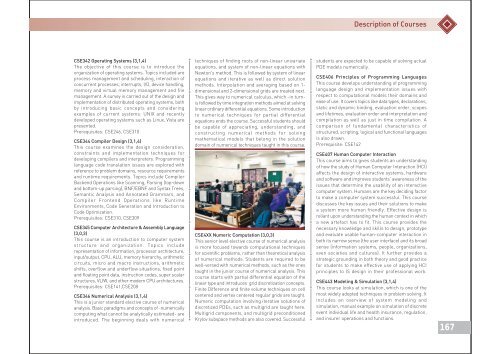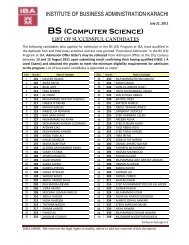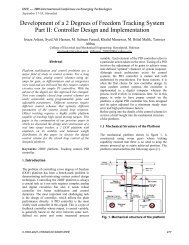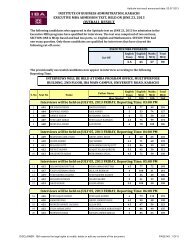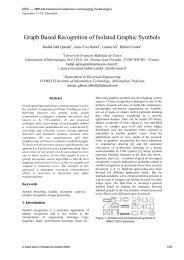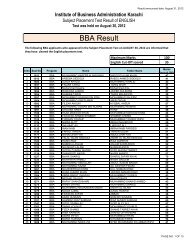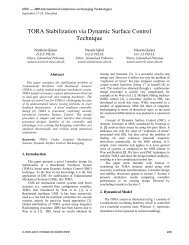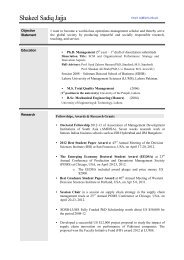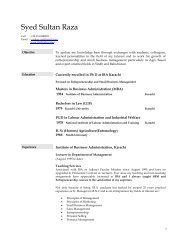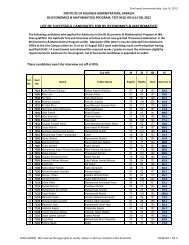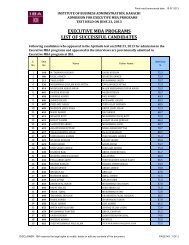Program Announcement 2013 - 14 - Institute of Business ...
Program Announcement 2013 - 14 - Institute of Business ...
Program Announcement 2013 - 14 - Institute of Business ...
Create successful ePaper yourself
Turn your PDF publications into a flip-book with our unique Google optimized e-Paper software.
Description <strong>of</strong> CoursesCSE342 Operating Systems (3,1,4)The objective <strong>of</strong> this course is to introduce theorganization <strong>of</strong> operating systems. Topics included areprocess management and scheduling, interaction <strong>of</strong>concurrent processes, interrupts, I/O, device handling,memory and virtual memory management and filemanagement. A survey is carried out <strong>of</strong> the design andimplementation <strong>of</strong> distributed operating systems, bothby introducing basic concepts and consideringexamples <strong>of</strong> current systems: UNIX and recentlydeveloped operating systems such as Linux, Vista arepresented.Prerequisites: CSE246, CSE310CSE344 Compiler Design (3,1,4)This course examines the design consideration,constraints and implementation techniques fordeveloping compilers and interpreters. <strong>Program</strong>minglanguage code translation issues are explored withreference to problem domains, resource requirementsand runtime requirements. Topics include CompilerBackend Operations like Scanning, Parsing (top-downand bottom-up parsing), BNF/EBNF and Syntax Trees,Semantic Analysis and Annotated Grammars, andCompiler Frontend Operations like RuntimeEnvironments, Code Generation and Introduction toCode Optimization.Prerequisites: CSE310, CSE309CSE345 Computer Architecture & Assembly Language(3,0,3)This course is an introduction to computer systemstructure and organization. Topics includerepresentation <strong>of</strong> information, processor architecture,input/output, CPU, ALU, memory hierarchy, arithmeticcircuits, micro and macro instructions, arithmeticshifts, overflow and underflow situations, fixed pointand floating point data, instruction codes, super scalarstructures, VLIW, and other modern CPU architectures.Prerequisites: CSE<strong>14</strong>1,CSE208CSE346 Numerical Analysis (3,1,4)This is a junior standard elective course <strong>of</strong> numericalanalysis. Basic paradigms and concepts <strong>of</strong> -numericallycomputing what cannot be analytically estimated- areintroduced. The beginning deals with numericaltechniques <strong>of</strong> finding roots <strong>of</strong> non-linear univariateequations, and system <strong>of</strong> non-linear equations withNewton's method. This is followed by system <strong>of</strong> linearequations and iterative as well as direct solutionmethods. Interpolation and averaging based on 1-dimensional and 2-dimensional grids are treated next.This gives way to numerical calculus, which -in turnisfollowed by time integration methods aimed at solvinglinear ordinary differential equations. Some introductionto numerical techniques for partial differentialequations ends the course. Successful students shouldbe capable <strong>of</strong> appreciating, understanding, andconstructing numerical methods for solvingmathematical models that belong in the solutiondomain <strong>of</strong> numerical techniques taught in this course.CSE4XX Numeric Computation (3,0,3)This senior level elective course <strong>of</strong> numerical analysisis more focused towards computational techniquesfor scientific problems, rather than theoretical analysis<strong>of</strong> numerical methods. Students are required to bewell-versed with numerical methods, such as the onestaught in the junior course <strong>of</strong> numerical analysis. Thiscourse starts with partial differential equation <strong>of</strong> thelinear type and introduces grid discretization concepts.Finite Difference and finite volume techniques on cellcentered and vertex centered regular grids are taught.Numeric computation involving iterative solutions <strong>of</strong>discretized PDEs, such as multigrid are taught here.Multigrid components, and multigrid preconditionedKrylov subspace methods are also covered. Successfulstudents are expected to be capable <strong>of</strong> solving actualPDE models numerically.CSE406 Principles <strong>of</strong> <strong>Program</strong>ming LanguagesThis course develops understanding <strong>of</strong> programminglanguage design and implementation issues withrespect to computational models their domains andease <strong>of</strong> use. It covers topics like data types, declarations,static and dynamic binding, evaluation order, scopesand lifetimes, evaluation order and interpretation andcompilation as well as just in time compilation. Acomparison <strong>of</strong> fundamental characteristics <strong>of</strong>structured, scripting, logical and functional languagesis also drawn.Prerequisite: CSE<strong>14</strong>2CSE407 Human Computer InteractionThis course aims to gives students an understanding<strong>of</strong> how the study <strong>of</strong> Human Computer Interaction (HCI)affects the design <strong>of</strong> interactive systems, hardwareand s<strong>of</strong>tware and improves students' awareness <strong>of</strong> theissues that determine the usability <strong>of</strong> an interactivecomputer system. Humans are the key deciding factorto make a computer system successful. This coursediscusses the key issues and their solutions to makea system more human friendly. Effective design isreliant upon understanding the human context in whicha new artefact has to fit. This course provides thenecessary knowledge and skills to design, prototypeand evaluate usable human-computer interaction inboth its narrow sense (the user interface) and its broadsense (information systems, people, organizations,even societies and cultures). It further provides astrategic grounding in both theory and good practicefor students to make effective use <strong>of</strong> applying HCIprinciples to IS design in their pr<strong>of</strong>essional work.CSE443 Modeling & Simulation (3,1,4)This course looks at simulation, which is one <strong>of</strong> themost widely adopted techniques in problem solving. Itincludes an overview <strong>of</strong> system modeling andsimulation, manual example on simulation <strong>of</strong> discreteevent individual life and health insurance, regulation,and insurer operations and functions.167


